I blinded him from what was
Hopefully, the times when I wrote a meticulously detailed article [ mirror ] about installing a liquid cooling system in a computer have not been forgotten. The information was unusual because there I looked at the whole process on a rather complex example - a rare case of complex construction, inside of which the task was to efficiently cool more than the productive stuffing.

Then many asked to tell about the stuffing itself - and once promised ...
Immediately I will warn that this article is not a manual for assembling a computer or an example to follow - the choice of some components is more than controversial for ordinary home use. Rather, it's just a pre-New Year story of one unusual computer, without any global meaning. As Deniskin said in one of the podcasts, “ geeks are very friendly in sharing information ” is a very accurate definition for this post, so read who asked and who are interested in similar stories;) It would be great if the comments are not just remarks like “ what for you such a computer, it would be better to change the nine "and" so what? I still have it cooler ”, namely the“ sharing of information ”- thoughts about the system, talking about the future of technology and the relevance of choosing one or other components, experience and rake of buying components in a particular place, existing problems, their solutions, life hacking and little tricks ... Down with boring comments! )
')
The comp was going leisurely, as far as possible, from the middle of summer. Now on the IXBT website a popular vote is being held - it is even interesting, in how many cases I have not lost my choice;) And now, if no one is against it, I will start.
It is necessary to start assembling a computer from the motherboard - without a “mother” nowhere to go) The choice is extremely huge - there are many manufacturers, each has a huge model line ... What should you do in such cases? In fact, nothing complicated. The only thing you need is to decide on the tasks that you want to solve on a computer. Write down the requirements on a piece of paper and select the model of devices that satisfy them and fit the budget. So what is next? And then we understand that all devices are so pretty, which is why the eyes run and it becomes difficult to make a choice. The problem is solved simply - you need to try to find the flaws separately for each device and see with which of the found you can live and with what not. This advice is ideal in many “agonies of choice”, but in the case of motherboards there are quite a few unobvious things - it is not at all superfluous to read reviews, weigh “FOR and AGAINST”.
In my tasks, or rather the requirements, it was not clear what - socket 1366 (only on it you can assemble a really powerful system, with a memory car and, if necessary, with a full-fledged SLI system), and then abstract ideas about the final product. Namely, something technological (if you are engaged in further tester activity, you cannot do without a full set of the latest technologies), productive and promising (“for growth” - so that the possibility of upgrade and support will not go away in six months) and ... yes, , everything. In theory, with all sorts of third-party controllers, similar functionality could be obtained even on budget mothers, but I wanted at least everything at once, that is, out of the box - if you assemble an “interesting” system, then do it from beginning to end.
The desire to assemble a system on water cooling helped me to finally decide on it - the evening after conversation with Max ( MadDude ) and I realized that the least trouble would be in my way if I took something “purebred” (sometimes I’m willing to pay for dressing - nice when beautiful). That is, such a fee, for which there are already various accessories - yes, the same fullcover-water blocks. Having talked with overclockers, the circle of "mothers" narrowed down to only three models, from which the most promising (in terms of price / quality ratio and availability of sane service) to me seemed ASUS Rampage III Extreme . I had to give up other options for another reason - due to the lack of water blocks / Do not consider advertising, but in the end I stopped at ASUS who were close to me - they were very interested in the characteristics, availability of necessary components, design / color (for harmony with the case) and numerous positive reviews of people I know.

Luxury equipment, an excellent set of interfaces (four PCI-E 16x, one PCI-E 4x and PCI, 11xUSB, two of which are versions 3.0, 2xFireWire, 2xSATA 6Gb / s and 7xSATA 3Gb / s, one of which is powered by eSATA), many technologies and features, high-quality component base and, as a result, stable work.

I will not talk in detail about this motherboard - if you want, I will write separately, but later. Let me just say that there are really no problems with it yet (t-t), and the accessories are not just there - you can even pick them up. For example, the problem of overheating the chipset (which is found on some samples in which the factory thermal grease dried) was solved by installing the same fullcover-waterblock (for this mother there are several varieties for every taste), which went just perfect - almost sure which in other cases would have to seriously interfere with the file.
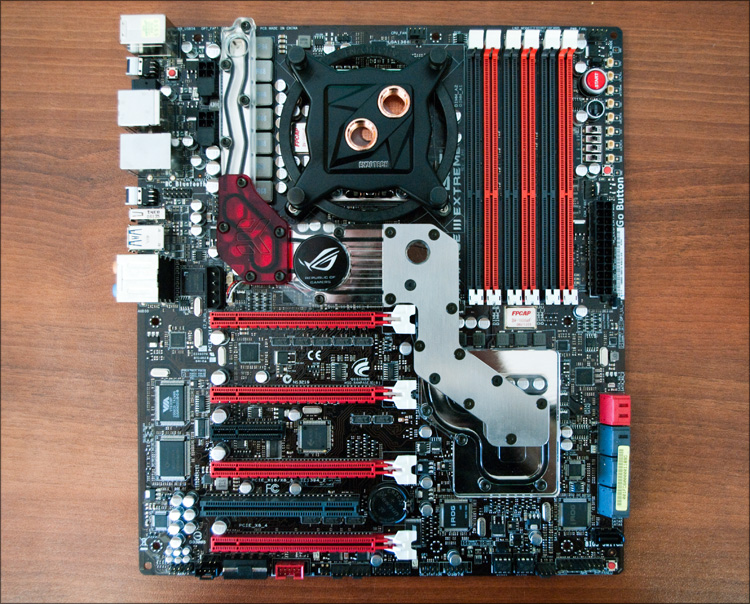
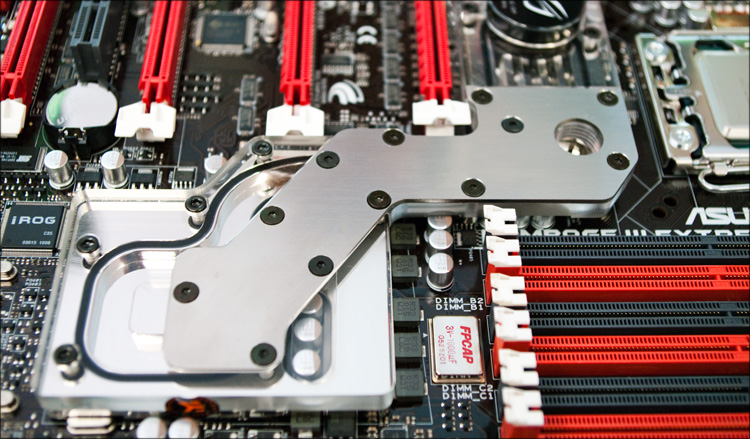
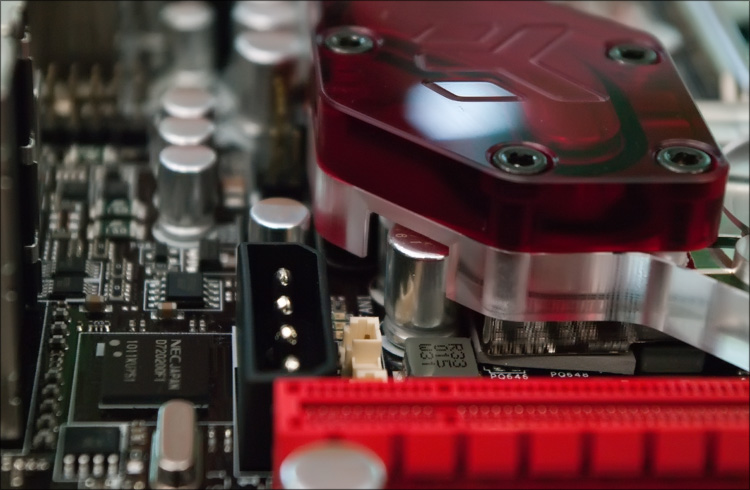
The only drawback so far is that there was only one USB connector on the board, to which wires are connected to bring the connectors to somewhere outside. Accordingly, out of 4 ports on the front panel of the case, only 2 work for me - all other devices have to be connected to the back of the case (where there will be enough USB ports for all). Who knows the easiest way to solve the problem?
At that time, the price for the “third rampage” was a considerable 15 thousand, which, in principle, was competitive compared to the other models mentioned. By the way, the opinion is mistaken that once I write on the blogs of Intel and ASUS, it means that I bathe in the “iron” health baths, that I am given parts in packs and that I am not treating anyone so angry with huge discounts ... no, friends, I have with them all is not so that sometimes upsets himself. The cobbler was without boots - he bought at Yulmart in the order of the general queue)
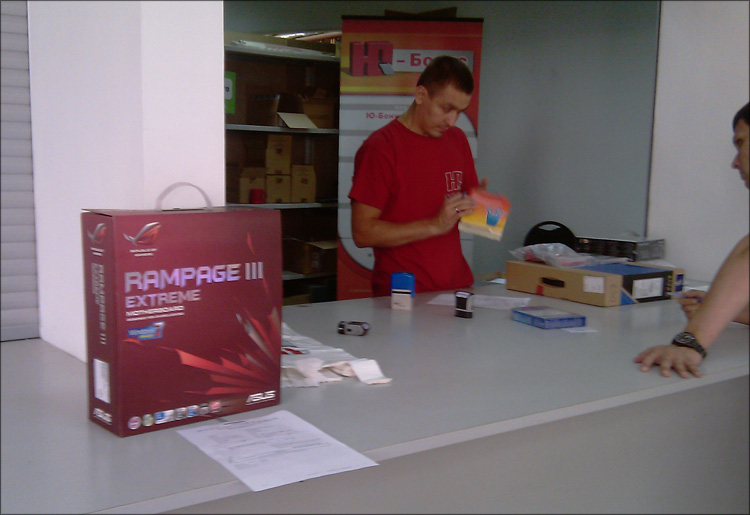
But these are trifles - you will think, I did not eat for a couple of months ... but I collected what I wanted)
When a socket is defined, it remains to choose a processor for it - taking into account the tasks that are planned to be solved in the future. Having looked at the list of processors compatible with a 1366 socket (and having written the prices opposite to the models interesting to me), I chose what was most accessible with the highest characteristics. Simply put, there was enough money only for the Intel Core i7-930 - everything that was higher than it was worth unreasonably expensive. More, in principle, and was not required - the previous processor (similar in characteristics and price of Intel Core i7-860) was quite enough. I looked through the magazine CHIP - every month they make a very useful and visual tablet with a rating of processors ... having looked at that, I finally made my choice. So, 4 cores (Bloomfield; 45nm), a nominal clock frequency of 2800 MHz, 8 megabytes of L3 cache and a maximum power consumption of 130W - from now on I live with it.

I took the usual OEM-version, which is sold, roughly speaking, in a bag - in this case there is a chance to buy a low-quality processor (for example, used, but carefully washed from the thermal paste). But I don’t see any point in overpaying for the BOX version (inside which, besides the processor, they put a noisy cooler), the vast majority of users install alternative (more efficient) cooling systems. So the advice is simple - if you are not sure, do not buy processors “in bags” on every kind of “Gorbushki” and “Sovek” there - take them in a good wholesale and retail store, where you will be given documents that have at least some strength.

Looking ahead - at a temperature of 40-45 degrees (60-65 in the load), a pebble works fine at a frequency of 4200 MHz.
This component of the system is the most rapidly “aging” - new vidyuhi appear like mushrooms after rain. But in reality, they “become obsolete” only conditionally - if not playing (namely, games are the main engine of progress), then the “golden mean” is enough for many users without the support of the latest directories and other goodies. Nevertheless, I wanted the video card not to be a bottleneck of the system for a long time and to correspond in general with all the components. That is, it was necessary to have a device with a perspective, which can be hidden once in the iron "chest" and forget about it all for a relatively long time.
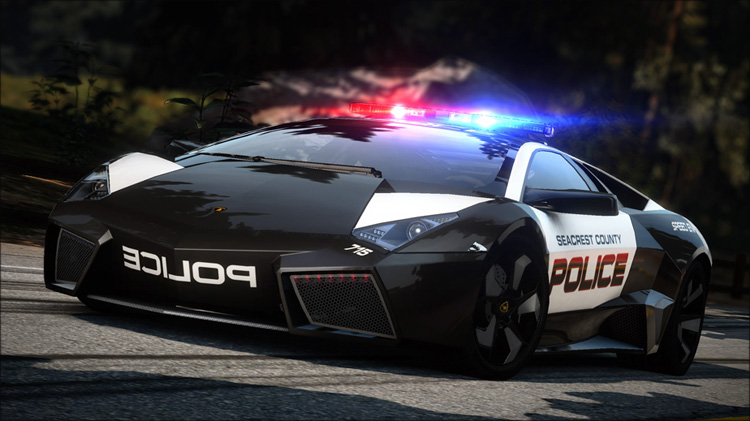
Now this is my son's favorite game - I even had to buy a steering wheel)
Despite the more advantageous pricing policy of ATI products, I’m used to NVIDIA - I don’t know, it just happened that way. At the moment, the flagship graphics cards of this company are GTX 580, but at the time of assembling the system (as it was at the end of the summer), there were no mention of them either. Then the GTX 480 reigned, on which I decided to stop. By the way, the choice then was not great at all - the 480s cost as the launch of the shuttle, and the entire range was presented by only two manufacturers, Leadtek and Zotac. Moreover, the Zotac board was significantly more expensive, due to the slight factory overclocking (AMP version) and the fact that an alternative cooling system was installed on it. I didn’t have to choose at all - if you still consider that to build a computer with a water-cooling system, I needed a reference design card.
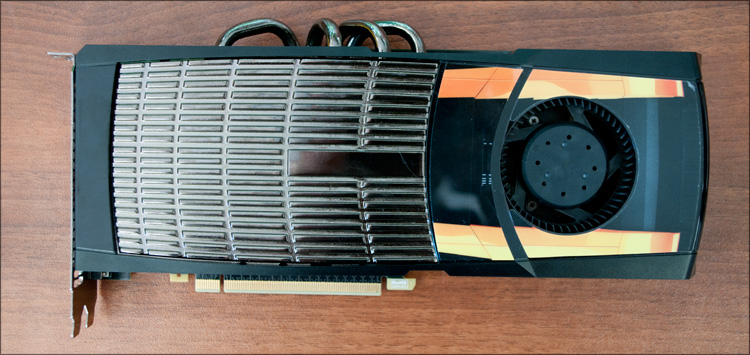
The video card is a beauty, Leadtek GeForce GTX 480 - initially this board takes up two slots - thanks to the cooling system, which with its entire look reminds me of a “waffle iron”. But such devices are supposed to be big;)
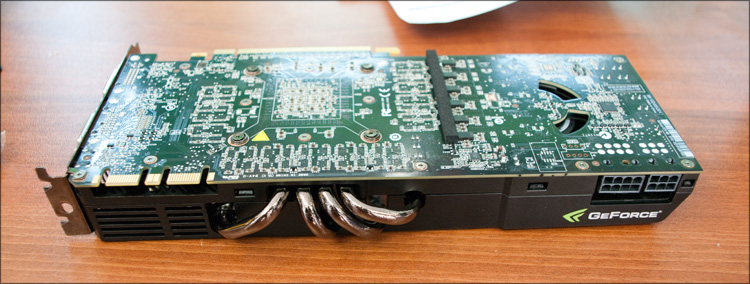
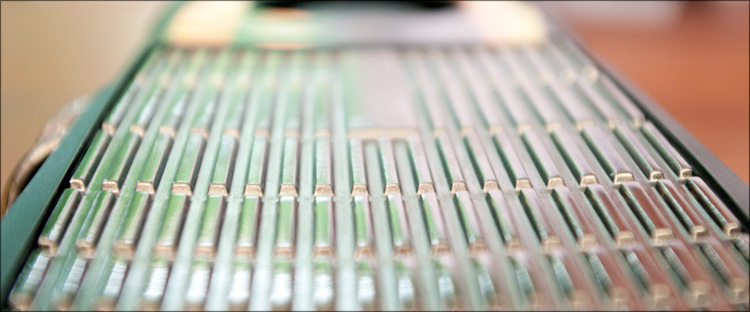
There is also a high power consumption - the manufacturer recommends using a power supply with a minimum power of 600W. The presence of the miniHDMI connector seemed strange to me - it’s good that the adapter was included, but it’s not clear why you couldn’t use a full HDMI.
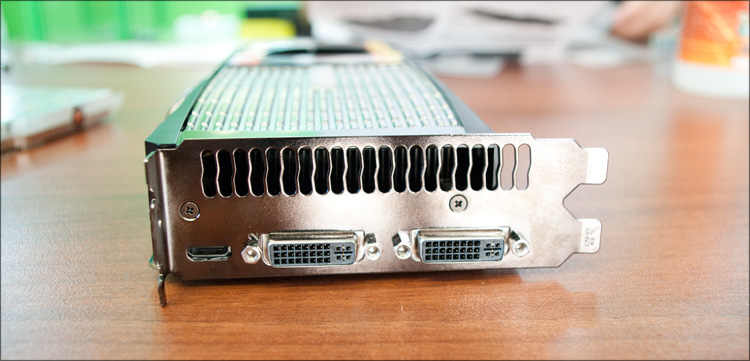
The rest - some pluses. 1536MB of 384-bit GDDR5 video memory (with a frequency of 1848 MHz - effective 3696 MHz), the frequency of the GPU / shader unit is 700/1401 MHz ... all this is already out of the box providing high performance, which is enough even for the most demanding games and applications. The hardware support for physical calculations, the built-in sound chip are also a kind of advantages, although not so important.
The calculation turned out to be true - the fullcover-waterblock perfectly stood up for the reference design, thanks to which the video card lost twice and began to work absolutely silently in a beautiful temperature mode. And thanks to overclocking (about which just below), the performance of my Leadtek GeForce GTX 480 video card caught up with the flagship GTX 580 (without overclocking).

Visual plate with the characteristics of the main graphics processors:
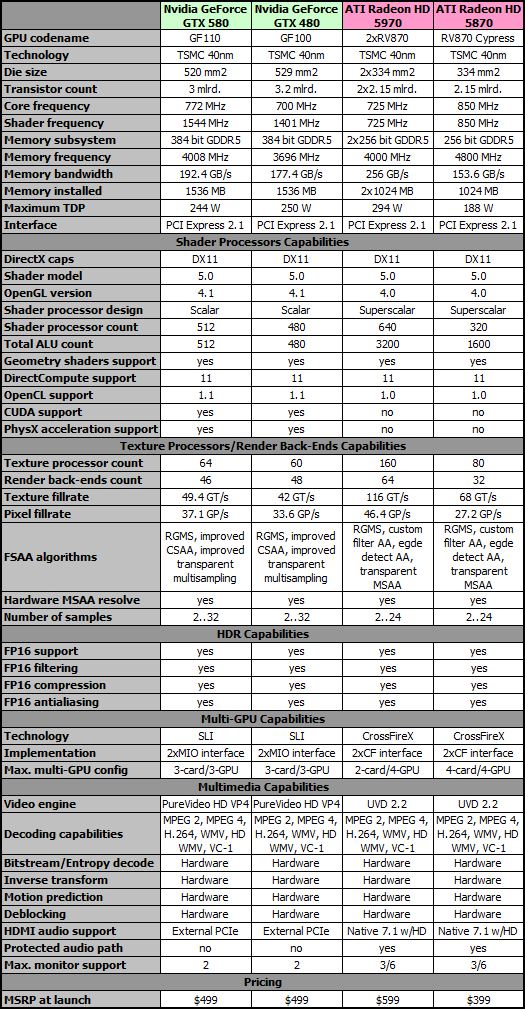
Now the price of the GTX 480 has dropped to 13-14 thousand, which decently raised the "price / quality ratio". GTX 580 is, in fact, "work on the bugs" (480, what would like to see it), but at the moment it is unreasonably expensive.
Many people do not attach much importance to this component, thinking that “since it does not affect performance, then why not sack off on it” is a fairly common mistake. Despite the fact that many new motherboards are full of all kinds of protections (including “from a fool”), there is always a chance to spoil the “wrong power” of the entire system unit. Therefore, a good power supply in expensive configurations should be required.
The power supply directly didn’t really affect the performance at all, so I had only two requirements - so that it was modular (the extra wires always annoyed me), pulled all the installed hardware (and had a small margin to overclock or install additional components), while working as quiet as possible. The option "choose BP by weight - the harder the better" is quite right to live, but manufacturers have gotten the hint and now almost all "serious" power supplies weigh decently) As such, the opportunity to "feel" (or at least listen) selected I did not have power supplies, so I agreed to the DeDaL option — to come and see what Thermaltake is offering.
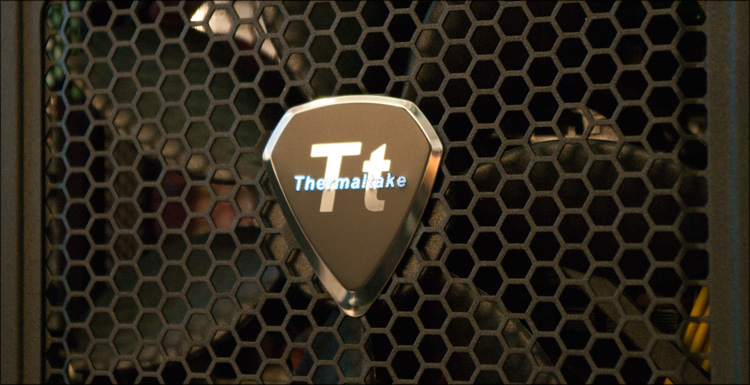
He had about a dozen BP of different manufacturers on the table - as it turned out later, they were all killed by overclockers and he was picking on each of them out of interest. With my “system requirements,” he with a smile waved his hand and said, “I have something that will suit you just perfectly.” After these words, Sarkis pulled a large black box from the shelf, in which there was a 750W Thermaltake Toughpower Grand who had seen the types of BP - it was he who repeatedly used as a “basis” for his overclocking feats.
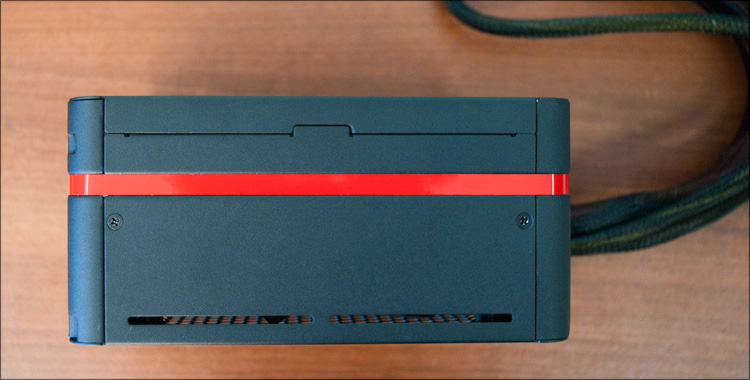
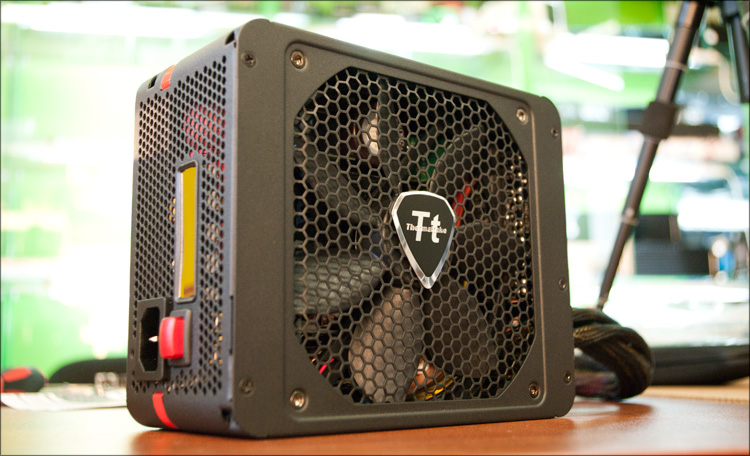
Initially, I planned to take something no less than a thousand, but DeDaL convinced me that 750 “from Grand” is enough for my eyes. The unit has a single + 12V line with a maximum load of 60A, which simply cannot be enough for modern reproduction processors and video cards. A little later, in a black and black room, we connected a black and black power supply to a special test bench, which allows us to create any load for the power supply.
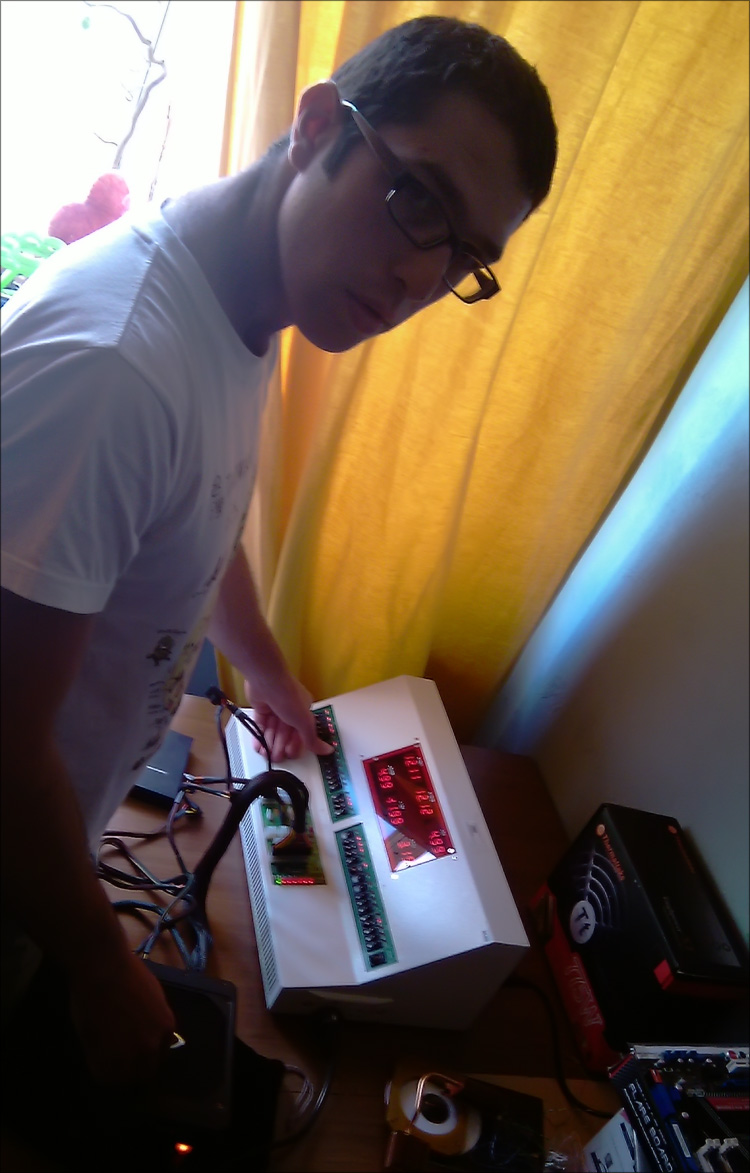
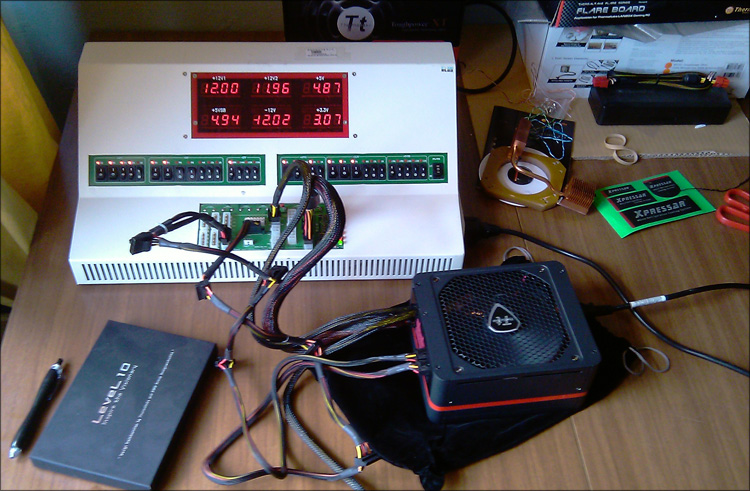
Half an hour of stress test and excellent performance as a result - almost no heating (high-voltage wires were also cool) and the lack of "sagging" on all lines - a high level of efficiency gives everybody the right to wear the 80+ Gold label. But what surprised me the most was the lack of noise from work even in load mode (despite the presence of a specially designed 140mm cooler; by the way, this cooler continues to spin for another 30 seconds, cooling the components heated during operation). Hi-End in an explicit form - ranging from packaging and packaging, ending with excellent performance.

The stylish appearance (in my case, it’s true, in the case will be extremely unnoticeable), an amazing package bundle - all this together I was completely satisfied and I didn’t even look for anything else anymore.

This is where I’m not shuffling at all - for me all the timings for one person) and in everyday work the only problem of “memory” was that it was sometimes not enough. So I just decided to take it a little more, for the start of gigs 6 - three strips of 2GB each. Accordingly, three more strips can be put in the future, but so far this is not necessary.
Here I fully relied on Vlad's taste ( slamms ), which the Crucial Ballistix Tracer Blue (3x2GB, PC3-12800 1600MHz, 8-8-8-24) recommended to me.
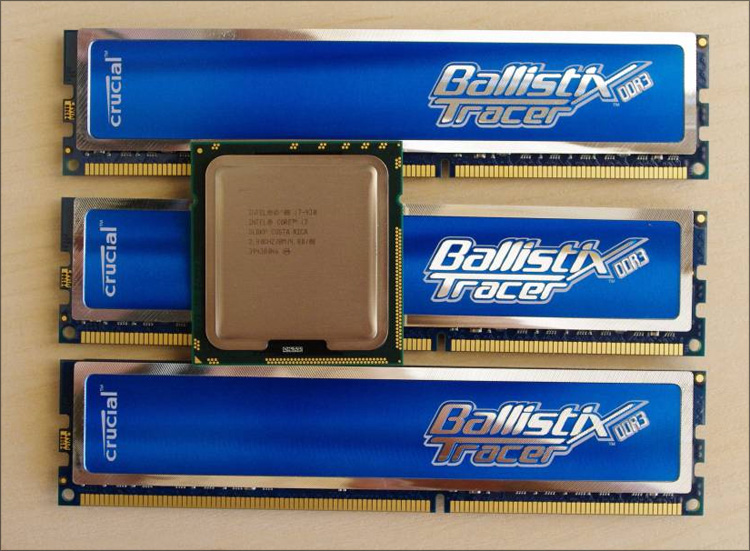
I do not know why I listened to it :) Everything would be fine - the memory works fine ... but I found out that the bars are decorated with a scattering of LED indicators only after the purchase :) Maybe someone would like light music and like it, but for me was an unpleasant surprise.
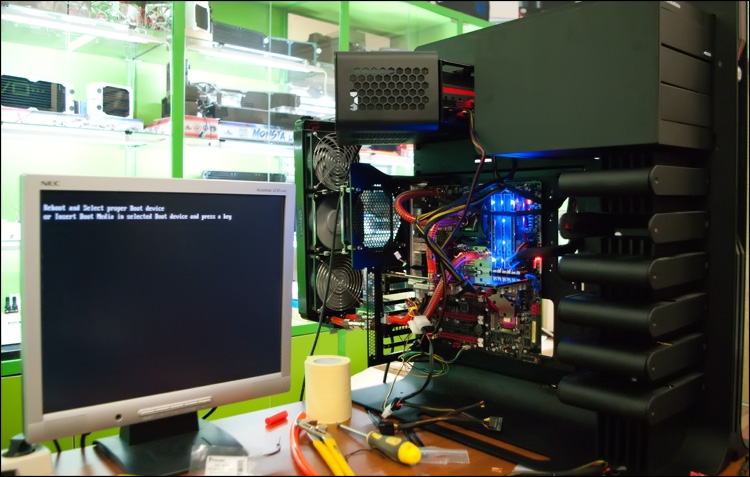
I bought the memory (and the processor) at the Just store - unfortunately, they refused to change the memory for this “reason”. Maybe they are right, but for me it was the last straw for the final withdrawal from buying something in this store. From now on, I fiercely recommend everyone to Yulmart - that's where the good service, range and prices are (it's a pity that then this memory was simply not there). I don’t know how it is with the “return”, but apparently, thousands of hamsters cannot be mistaken (my Twitter poll gave similar results):

It is good that the light from the LEDs almost does not extend beyond the enclosure. But I don’t know what to do next - either take three more of the same slats (then it will definitely be light), or take six slats of the well-proven Kingston (which will be more expensive). In general, while I have what I have - 6GB is enough for my tasks.
The fact that as the basis will be the SSD-drive, I had no doubt - they are very attractive in many ways. For example, high speed, noiselessness and low temperature (mechanical strength and low power consumption in my case were not fundamental). There are also disadvantages (high price, small volume, potentially “small” resource), but where they are not in our time.
Data is not so bad to lose in the event that you make backups - the most important thing for me, it seems, is saved. A small amount ... well, yes, there is such a thing, but the SSD is not bought for storing HD movies - a small volume should be enough for the system. So, by and large, everything came up against the price and then I decided to follow the simple path - to take the “middle ground”. This middle was the 128GB WD SiliconEdge Blue storage device (built on the MLC memory, on the JMicron 612 controller), which cost “only” 8500 rubles - for this money, competitors offer only 80 GB models (in particular, the mainstream X25-M from Intel and a similar model from Kingston - the rest I did not even look).
What is he good at? Well, first of all, the volume - any software will fit on 128GB and even remain. Good read and write speeds are 250 and 170 MB / s, respectively (in theory). NCQ support and TRIM teams - it’s probably meaningless to take a disk without them. Well, what else do you need from the disk? In general, he took without hesitation. Although no - this comparative test still made a useful contribution when choosing;)

As for the service life, the manufacturer promises a time between failures of about 1,400,000 hours, which, when recalculated in a year, gives a greater figure.Of course, this figure cannot be trusted anyway - there are a lot of different factors here ... and it’s good if the disc works for at least a couple of years) But I don’t want to lose even the saved data, therefore, on the advice of a friend, I decided to do the following.
As you know, SSD-drives operate with data blocks of 4Kb - this does not cause any inconvenience during recording, however, page-by-page (4Kb) deletion during data deletion is impossible - you can reset only 512Kb sector. And since 512Kb is not necessarily part of a single file, before deleting the "unnecessary" disk, you will have to once again do operations to move the "necessary" parts of the files to other areas of the drive. It is easy to guess that the greatest harm from such movements will be when the available volume is full - even if there is support for TRIM, the data will simply have nowhere to move. Because of the convulsive movements of tiny amounts of data, the disk will do a lot of unnecessary read-write operations, which, following logic, is the right way to ruin the resource of the drive - to defragment it is not an option here:) To avoid this unpleasant picture, I created a section of only 110 GB of the available 128 — all other memory cells at the physical level will always be available so that data can be moved to them.
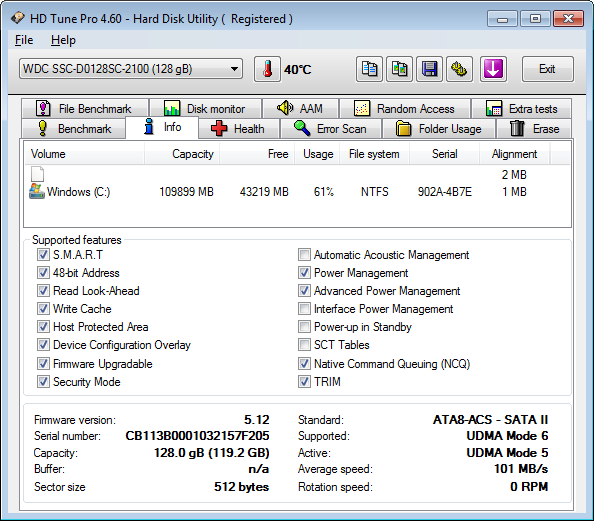
Since I considered only Windows 7 as an OS, I didn’t take any additional actions during the installation of the system - unless I turned off a couple of extra services after installation. Three months have passed - the disk rustles works without complaints. The only pity is that only 128GB - practice has shown that this, of course, is not enough :) The
speed performance of the WD SiliconEdge Blue SSD-drive SSC-D0128SC-2100. Reading:
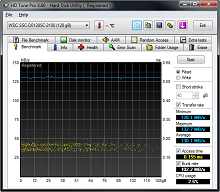
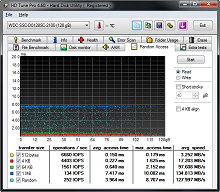
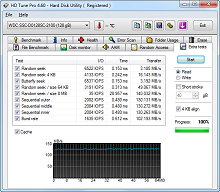
Record:

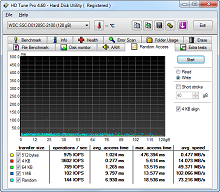
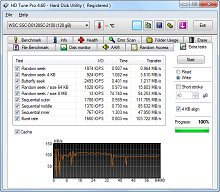
Of course, one SSD drive in the system was not enough - for the rest of the files I put a terabyte WD Caviar Green WD10EARS , which I already wrote about once .

5400 turns (so that it was quiet), large (64MB) cache, increased sector size (4K instead of 512 bytes) and a small price. This disc was hidden in a special anti-vibration housing and installed down under the Bluray-drive (in the compartment for 5.25 '' devices).
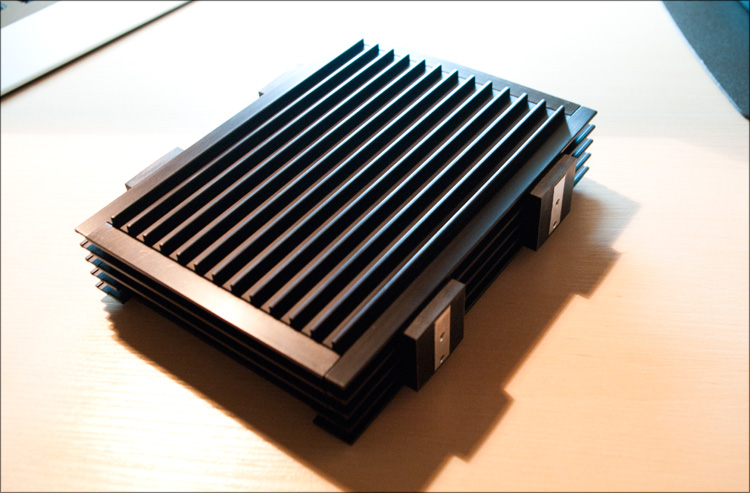
As a result, the disk system of the computer is completely silent and sufficiently productive. The volume is quite enough - everything is “unnecessary” and the volume is dumped on the network drive ... but in principle, it would be better to put a more capacious disk - the same WD has now released interesting 3TB models.
Speed indicators WD Caviar Green WD10EARS. Reading:
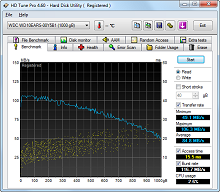

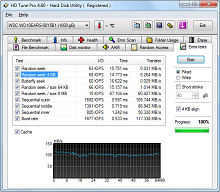
Record:
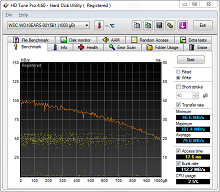
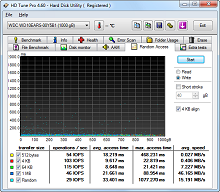

I think a bunch of SSD + HDD in our time is one of the most profitable solutions - I took a little more than 12 thousand rubles for this bundle, but in addition to all the advantages, I also received noiselessness. About people's love for WD:

As I already said, all this iron platter was going to the amazing Thermaltake Level 10 building , which is unusual for almost everyone - I already reviewed this tower and told in detail about the assembly of the liquid cooling system using the example of this building. I will not repeat, I will say only a few words about the practical side of use - for all the time I was tinkering, I learned all the secrets of this corps.

This case is very heavy. HIGHLY. If initially it weighs under 30kg, then with all the iron installed the arrow on the scales began to go off scale for 50kg. I understand that this is not a laptop and I don’t have to carry this wardrobe in my backpack every day, but I managed to suffer - for example, when I went to install ITS ... while you pull it out of the car, while you carry it, you bring it ...) But the minus is half plus - in this case, the large weight provides the body with excellent stability and solidity, which any vibrations on the drum. Yes, and the weight is largely due only to thick walls - this is well contributed to noise insulation.
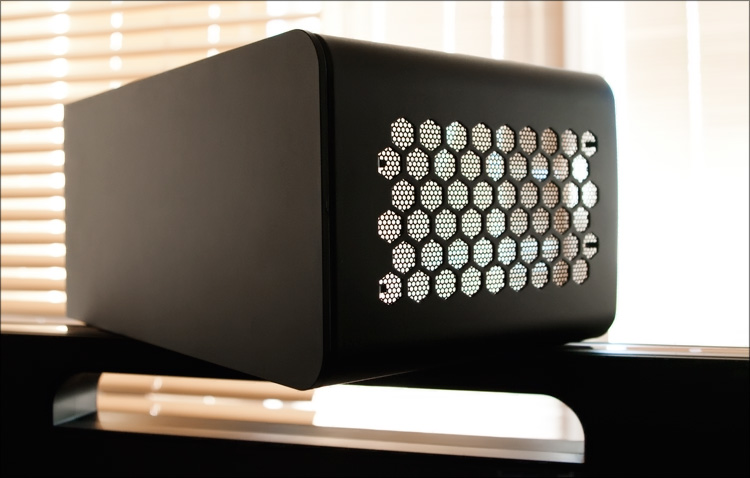
The case is very thought out. So thought out that during the assembly I wondered how it was generally possible to predict and take into account so many nuances that will inevitably occur during the assembly of the system. I will not enumerate everything (forgot), but I will say this - almost everything is unscrewed, removed and switched off. So, for example, without a screwdriver, all system compartments and the back wall cover are removed, after which a “mounting wall” is formed in front of the user, assembling a computer on which is more convenient than in any other case.
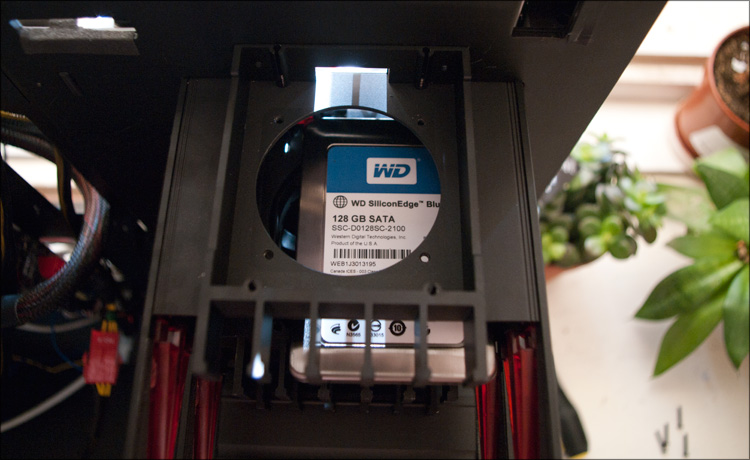
Wanted to put something in the compartment at 5.25 ''? Just remove the desired compartment from the case, put it on the table and there already leisurely carefully fasten everything ... and then you hang it back and close the hinged lid.

There is access to everything and from any side - nowhere hinders anything. Places just in bulk, including in the space between the back wall and the motherboard - a paradise for those who like to be smart when laying wires. The backlight is turned off, all the wires from it (and from all elements of the front panel) are neatly laid in a special chute, because of what they do not

catch the eye at all… in this case, the designers of BMW (namely, they designed the case), I have only respect and respect. The assembly of the company was an interesting quest - it is even a pity that the file was not useful anywhere)

In general ... the body is expensive, but it is definitely worth it - it is not just an image thing, it is still a great example of a practical implementation of a bold and unusual design idea.
Since I started talking about cable management, the next paragraph is quite suitable for a logical transition to the overclocking section;) I wrote earlier that the entire system is cooled by a massive three-section radiator, which is blown through three silent coolers. All is good, but the connecting wires of the coolers are very short and ugly. The problem was solved quite simply - Noctua coolers (which in the amount of three pieces were on my previous computer) had extremely long “tails” in a practical and beautiful “skin” - if earlier I didn’t know how to hide them prettier, now they are the other way around.
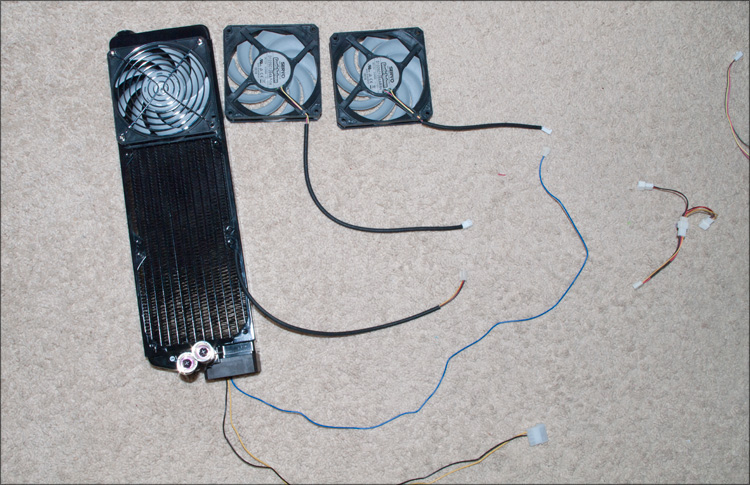
Cheap soldering iron, side cutters, half an hour of time ... and now all six coolers are soldered, each with a wire of the desired length;) On the radiator, I found a small chute into which previously hung wires fit perfectly.
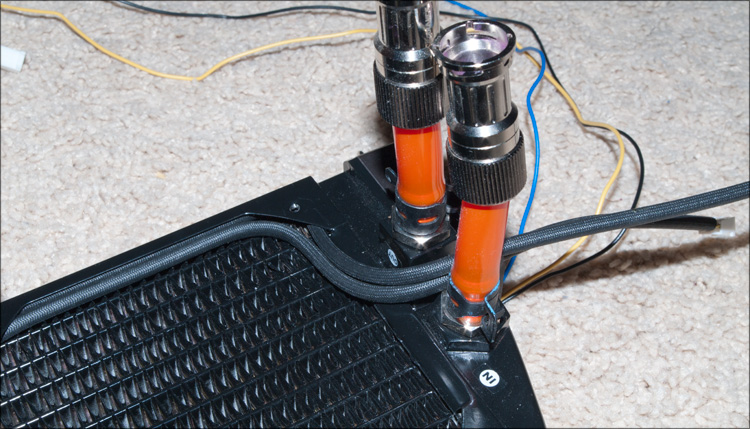
In order to dismantle the entire cooling system (it was not for nothing that the quick-release valves and mounting bracket were installed), the connectors for powering all the coolers were brought out through the cuts in one of the body plugs.
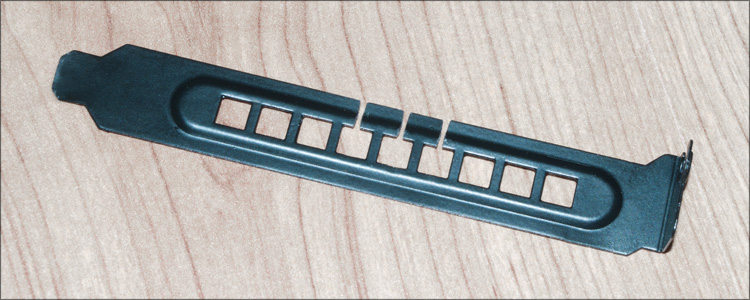
Now it is enough to disconnect the wires, turn the tubes and press the bracket - and now the body is ready even for the most severe transportation. As a result, it was still not as beautiful as I would like (I will work on it when I have more time), but much better than it was.
What else was used in the system unit? Yes, in principle, nothing more - the first BluRay-drive (for six months they never used it) and the discrete sound card ASUS Xonar HDAV 1.3 Deluxe (originally was ASUS Xonar Essence ST, but it didn't work out) - I don’t think what is now worth a separate talk about these non-core things.
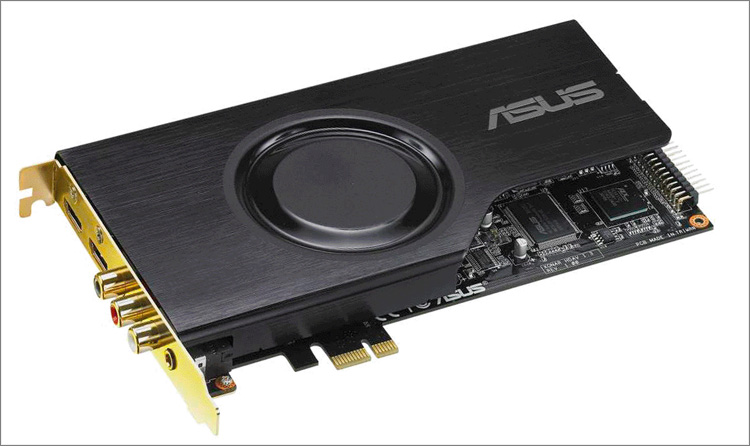
Such systems are not going to just to please the eye - a profit should be in everything. Including the performance, which is still out of the box at a very good level.
I admit at once that I am far from a guru in overclocking, although I have always been interested in this subject. I tried to do something myself - it seemed to be possible, but I could not get rid of the understanding that this was not the limit at all. And I was a little afraid to do something further - most of all I didn’t want to disable the new system ... I think this is one of the most frequent factors stopping many newcomers. So one evening, the same funny guy DeDaL came to visit me - in my opinion, this is the third person from Habr who was on my balcony) In between conversations, he told me the basics, along the way, the potential for overclocking . There was no task to set a record or make the computer work in extreme conditions - I wanted “a reasonable maximum in the framework of stable work”.
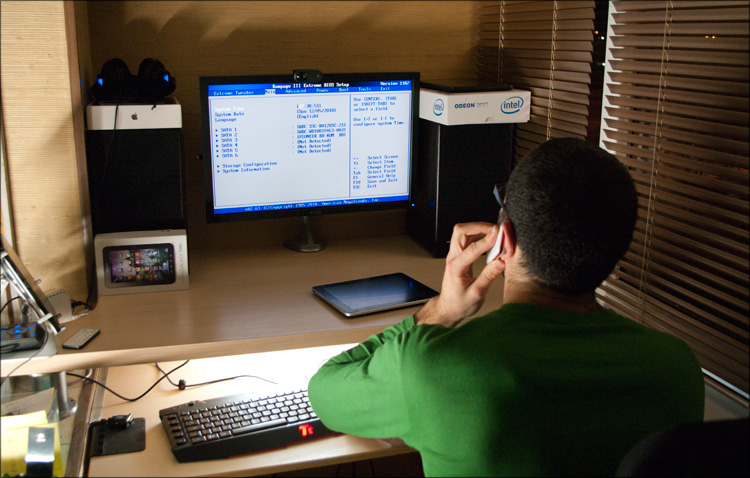
First of all, Sarkis studied the NWO and what I did with the body - I approved it in general) Then we immediately got down to business. The latest BIOS was downloaded to the motherboard, which was successfully requested.
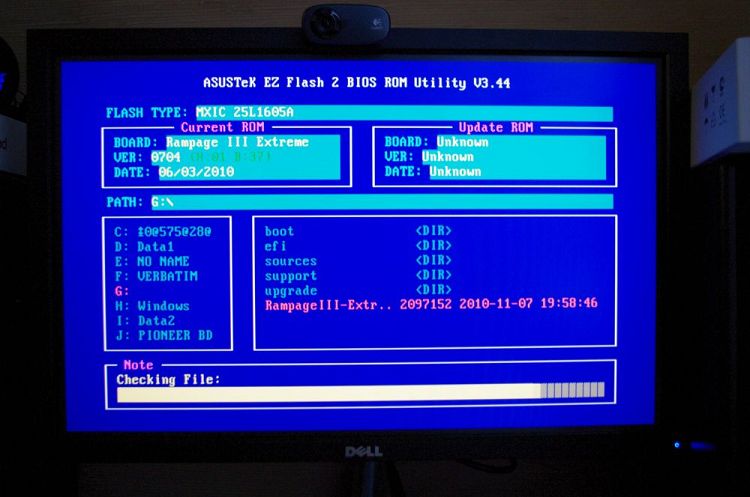
ASUS has a lot of interesting overclocking tools ( ASUS Turbo EVO and PC PROBE II ) and control of the overclocked system (ROG Connect allows you to connect a smartphone or laptop and edit all the parameters from it). But it is more interesting to pick it all up manually, so we climb into the BIOS - there it’s worth starting with turning off all energy saving features and other green features. Reboot - everything works.
We go to the ASUS Extreme Tweaker - in this section of the BIOS is all that relates to overclocking. A good “ceiling on the water” of the first versions of the Intel Core i7-930 processor was about 4600+ MHz (with factory 2800) - now these figures can be quite difficult to achieve. We decided to limit to 4200 MHz (21 * 200 MHz; despite the maximum multiplier of 22, Sarkis advised using an odd multiplier) - at this frequency all voltages were more or less within reasonable limits and allowed to work stably for a long time. Additional megahertz people would hardly have made the weather - they would have had to aggressively increase the voltage, and this would no longer be desirable. The settings are as follows:


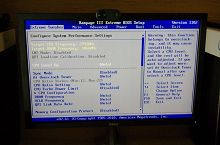
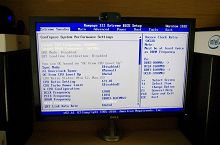
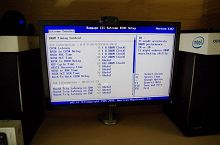
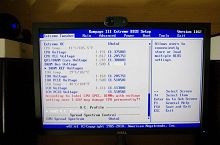

All settings were saved in a separate OC-profile of the BIOS, which at any time allows you to switch between them - I wanted to save energy - I chose the most economical mode; I wanted to pay for electricity - I chose the profile “DeDaL” and began to increase uptime;) By the way, the CPU consumption in the maximum mode is negligible compared to how much the video card eats ... so you should not worry too much about it.

It is noteworthy that the version CPU-Z from version to version surprises with its readings. Here, for example, two windows - pay attention to nuclear voltage)
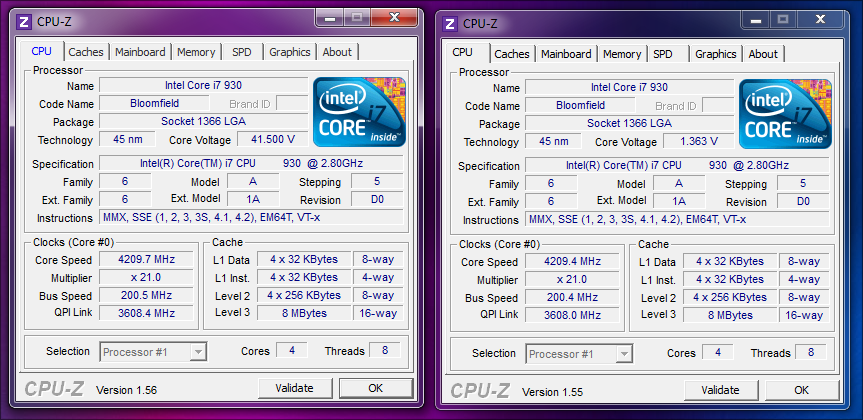
The temperature mode is normal - at 100% load of a 4.2 GHz processor, the temperature on the cores did not exceed 68 degrees. And in the mode of the usual "office" work modest 40-45 degrees. Thus, the overclocking of the processor was neither more nor less than 50%.
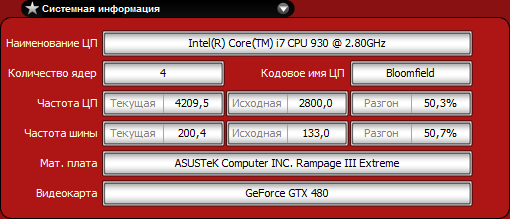
The video card is also a little tortured. Alternatively, you could use the functional MSI Afterburner , which allows you to change the voltage on the core, but I suggested that DeDaL use the good old EVGA Precision - this is a similar program in functions, the only difference from which is the MSI utility is the inability to change the voltage.
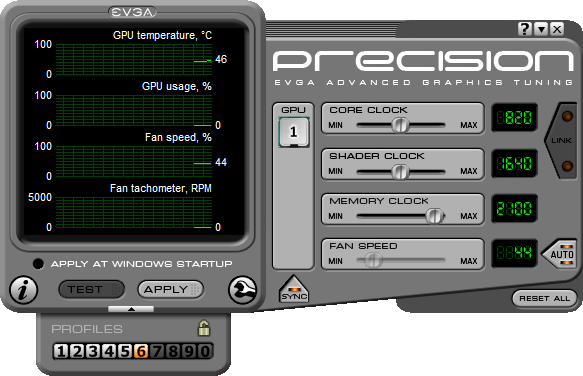
At this stage, the benchmark from 3DMark and Furmark also came in handy, which revealed the stability of work and temperature. The nominal core / shader / memory frequencies of the Leadtek GeForce GTX 480 are 700/1400/1848 MHz - the limit we needed was found almost immediately and amounted to 820/1640/2100 MHz, respectively. If my memory serves me correctly, the video card worked at frequencies up to 880 MHz on the core, but in this case there was no stability - in the middle of the test, the image on the screen became artifacts. Therefore, we gradually “passed back” until overclocking under load conditions ceased to be a detriment to stability. This means that in more benign modes, the video card should work just as well, which it actually does. The temperature of the GPU in the load rose from 44 degrees to 58 - a very good indicator.
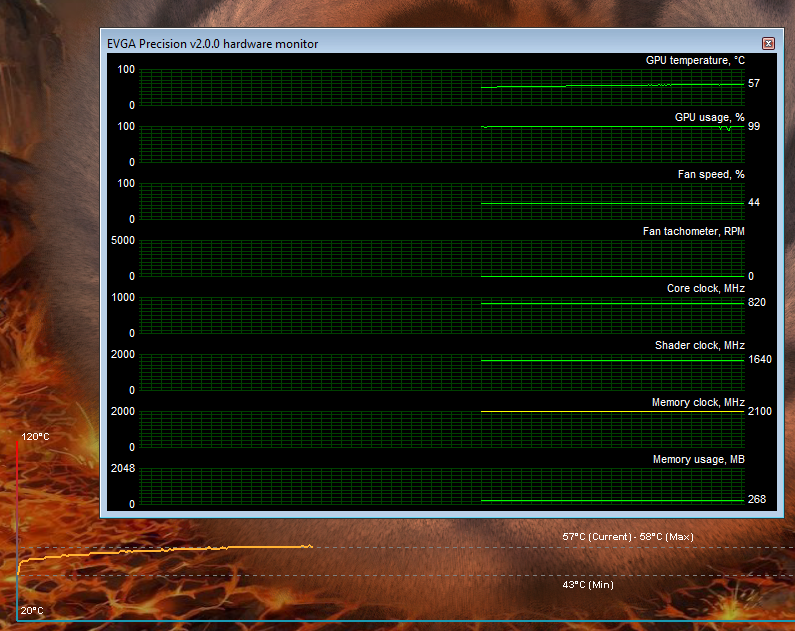
In this mode, the performance of my GTX 480 on tests caught up with the flagship model GTX 580 (without overclocking) - and you ask, why do overclocking;)
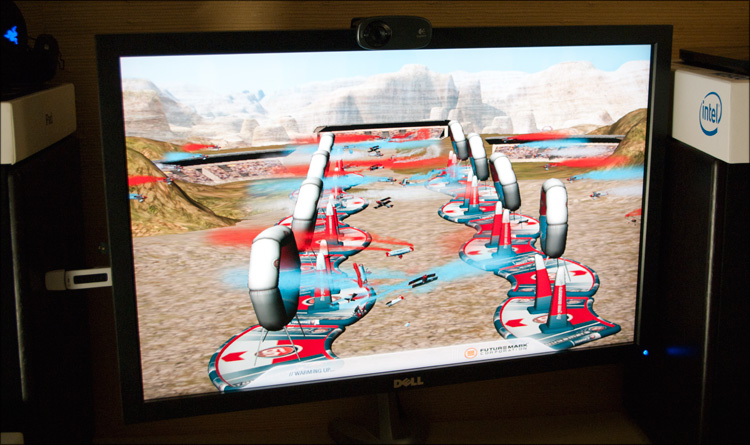
The number of "bagels" in this test from 3DMark means the number of cores (including HT)
The abstract performance index during overclocking also slightly increased - in terms of memory and processor. It was and became:
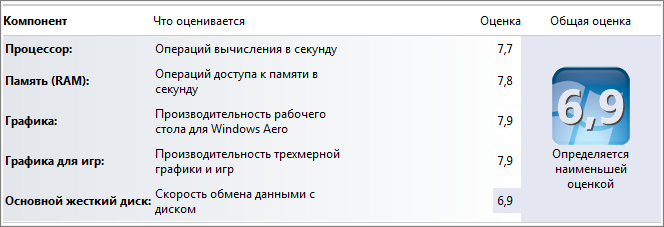
I agree that the figures obtained are far from the records, but I repeat that no such goal was set. Well, a few numbers for comparison (already in overclocking):
3DMark Vantage - P26384 , X11721

3DMark11 - E9489 , P6071, X1958
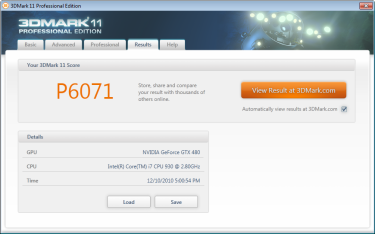
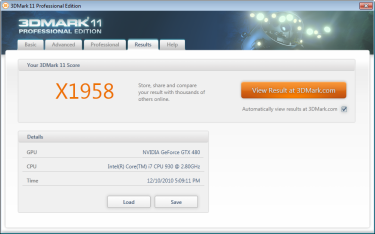
Loading an operating system (Windows 7) takes an average of 25-30 seconds, although about a quarter of this time is spent on initializing USB devices. If you have an idea how to fix it - please write (Legacy USB Support and PS / 2 keyboard do not offer)
DeDaL , slamms - overclocking monsters, remember the values of BIOS parameters from memory, with a closed eyes they can make some voltmod on a video card or accidentally splash liquid nitrogen on a top piece of iron and ask “Ha, scared?” With a grin. I invited them to Habr a long time ago - I think if you ask them politely for advice, they will not refuse. Immediately they run their blog iZine (and release the eponymous magazine), where they brag about records and write interesting articles about the iron of an enthusiastic level.
Donny , NeoForce - guys from the same team, only slightly older;) Special thanks to them for the advice and help in choosing the components. They can also plus karma;)
MadDude - it was he who fascinated me with a “designer” called “SVO” - from him I, perhaps, this year learned the most interesting things about iron) Specialist in water cooling systems from the Overhard store - I think you can always contact him for advice.
You can draw an analogy - even if you buy an expensive car, there will always be something in it that can be changed, supplemented or improved. Drivers spend time and money on it, thereby creating a unique image, which then ride a pleasure. And there seems to be no global sense in this, rarely can you accelerate to the limit ... but you want to drive and ride.
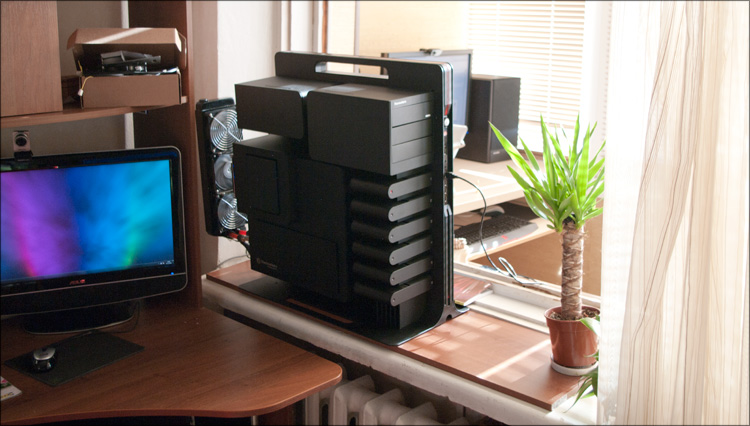
So here - there was no urgent need to create such a config ... but as soon as a small opportunity arose, as it immediately sucked into the process) It’s such a thrill to collect everything yourself, set up and now work on it .... The computer turned out to be a slaughter in every sense - by weight, by price (I think it exceeded one hundred), by performance. Appearance ... I do not know about you, but I literally orgasm from this miracle) Now almost everything is ready in it - looking at the calendar it turns out, this is my New Year's gift. What else does a geek need to be happy?
As a bonus - a short video by which you can estimate the level of noise from the work of the resulting system.
That's all. Happy birthday to me;)

Then many asked to tell about the stuffing itself - and once promised ...
Immediately I will warn that this article is not a manual for assembling a computer or an example to follow - the choice of some components is more than controversial for ordinary home use. Rather, it's just a pre-New Year story of one unusual computer, without any global meaning. As Deniskin said in one of the podcasts, “ geeks are very friendly in sharing information ” is a very accurate definition for this post, so read who asked and who are interested in similar stories;) It would be great if the comments are not just remarks like “ what for you such a computer, it would be better to change the nine "and" so what? I still have it cooler ”, namely the“ sharing of information ”- thoughts about the system, talking about the future of technology and the relevance of choosing one or other components, experience and rake of buying components in a particular place, existing problems, their solutions, life hacking and little tricks ... Down with boring comments! )
')
The comp was going leisurely, as far as possible, from the middle of summer. Now on the IXBT website a popular vote is being held - it is even interesting, in how many cases I have not lost my choice;) And now, if no one is against it, I will start.
Motherboard
It is necessary to start assembling a computer from the motherboard - without a “mother” nowhere to go) The choice is extremely huge - there are many manufacturers, each has a huge model line ... What should you do in such cases? In fact, nothing complicated. The only thing you need is to decide on the tasks that you want to solve on a computer. Write down the requirements on a piece of paper and select the model of devices that satisfy them and fit the budget. So what is next? And then we understand that all devices are so pretty, which is why the eyes run and it becomes difficult to make a choice. The problem is solved simply - you need to try to find the flaws separately for each device and see with which of the found you can live and with what not. This advice is ideal in many “agonies of choice”, but in the case of motherboards there are quite a few unobvious things - it is not at all superfluous to read reviews, weigh “FOR and AGAINST”.
In my tasks, or rather the requirements, it was not clear what - socket 1366 (only on it you can assemble a really powerful system, with a memory car and, if necessary, with a full-fledged SLI system), and then abstract ideas about the final product. Namely, something technological (if you are engaged in further tester activity, you cannot do without a full set of the latest technologies), productive and promising (“for growth” - so that the possibility of upgrade and support will not go away in six months) and ... yes, , everything. In theory, with all sorts of third-party controllers, similar functionality could be obtained even on budget mothers, but I wanted at least everything at once, that is, out of the box - if you assemble an “interesting” system, then do it from beginning to end.
The desire to assemble a system on water cooling helped me to finally decide on it - the evening after conversation with Max ( MadDude ) and I realized that the least trouble would be in my way if I took something “purebred” (sometimes I’m willing to pay for dressing - nice when beautiful). That is, such a fee, for which there are already various accessories - yes, the same fullcover-water blocks. Having talked with overclockers, the circle of "mothers" narrowed down to only three models, from which the most promising (in terms of price / quality ratio and availability of sane service) to me seemed ASUS Rampage III Extreme . I had to give up other options for another reason - due to the lack of water blocks / Do not consider advertising, but in the end I stopped at ASUS who were close to me - they were very interested in the characteristics, availability of necessary components, design / color (for harmony with the case) and numerous positive reviews of people I know.

Luxury equipment, an excellent set of interfaces (four PCI-E 16x, one PCI-E 4x and PCI, 11xUSB, two of which are versions 3.0, 2xFireWire, 2xSATA 6Gb / s and 7xSATA 3Gb / s, one of which is powered by eSATA), many technologies and features, high-quality component base and, as a result, stable work.

I will not talk in detail about this motherboard - if you want, I will write separately, but later. Let me just say that there are really no problems with it yet (t-t), and the accessories are not just there - you can even pick them up. For example, the problem of overheating the chipset (which is found on some samples in which the factory thermal grease dried) was solved by installing the same fullcover-waterblock (for this mother there are several varieties for every taste), which went just perfect - almost sure which in other cases would have to seriously interfere with the file.



The only drawback so far is that there was only one USB connector on the board, to which wires are connected to bring the connectors to somewhere outside. Accordingly, out of 4 ports on the front panel of the case, only 2 work for me - all other devices have to be connected to the back of the case (where there will be enough USB ports for all). Who knows the easiest way to solve the problem?
At that time, the price for the “third rampage” was a considerable 15 thousand, which, in principle, was competitive compared to the other models mentioned. By the way, the opinion is mistaken that once I write on the blogs of Intel and ASUS, it means that I bathe in the “iron” health baths, that I am given parts in packs and that I am not treating anyone so angry with huge discounts ... no, friends, I have with them all is not so that sometimes upsets himself. The cobbler was without boots - he bought at Yulmart in the order of the general queue)

But these are trifles - you will think, I did not eat for a couple of months ... but I collected what I wanted)
CPU
When a socket is defined, it remains to choose a processor for it - taking into account the tasks that are planned to be solved in the future. Having looked at the list of processors compatible with a 1366 socket (and having written the prices opposite to the models interesting to me), I chose what was most accessible with the highest characteristics. Simply put, there was enough money only for the Intel Core i7-930 - everything that was higher than it was worth unreasonably expensive. More, in principle, and was not required - the previous processor (similar in characteristics and price of Intel Core i7-860) was quite enough. I looked through the magazine CHIP - every month they make a very useful and visual tablet with a rating of processors ... having looked at that, I finally made my choice. So, 4 cores (Bloomfield; 45nm), a nominal clock frequency of 2800 MHz, 8 megabytes of L3 cache and a maximum power consumption of 130W - from now on I live with it.

I took the usual OEM-version, which is sold, roughly speaking, in a bag - in this case there is a chance to buy a low-quality processor (for example, used, but carefully washed from the thermal paste). But I don’t see any point in overpaying for the BOX version (inside which, besides the processor, they put a noisy cooler), the vast majority of users install alternative (more efficient) cooling systems. So the advice is simple - if you are not sure, do not buy processors “in bags” on every kind of “Gorbushki” and “Sovek” there - take them in a good wholesale and retail store, where you will be given documents that have at least some strength.

Looking ahead - at a temperature of 40-45 degrees (60-65 in the load), a pebble works fine at a frequency of 4200 MHz.
Video card
This component of the system is the most rapidly “aging” - new vidyuhi appear like mushrooms after rain. But in reality, they “become obsolete” only conditionally - if not playing (namely, games are the main engine of progress), then the “golden mean” is enough for many users without the support of the latest directories and other goodies. Nevertheless, I wanted the video card not to be a bottleneck of the system for a long time and to correspond in general with all the components. That is, it was necessary to have a device with a perspective, which can be hidden once in the iron "chest" and forget about it all for a relatively long time.

Now this is my son's favorite game - I even had to buy a steering wheel)
Despite the more advantageous pricing policy of ATI products, I’m used to NVIDIA - I don’t know, it just happened that way. At the moment, the flagship graphics cards of this company are GTX 580, but at the time of assembling the system (as it was at the end of the summer), there were no mention of them either. Then the GTX 480 reigned, on which I decided to stop. By the way, the choice then was not great at all - the 480s cost as the launch of the shuttle, and the entire range was presented by only two manufacturers, Leadtek and Zotac. Moreover, the Zotac board was significantly more expensive, due to the slight factory overclocking (AMP version) and the fact that an alternative cooling system was installed on it. I didn’t have to choose at all - if you still consider that to build a computer with a water-cooling system, I needed a reference design card.

The video card is a beauty, Leadtek GeForce GTX 480 - initially this board takes up two slots - thanks to the cooling system, which with its entire look reminds me of a “waffle iron”. But such devices are supposed to be big;)


There is also a high power consumption - the manufacturer recommends using a power supply with a minimum power of 600W. The presence of the miniHDMI connector seemed strange to me - it’s good that the adapter was included, but it’s not clear why you couldn’t use a full HDMI.

The rest - some pluses. 1536MB of 384-bit GDDR5 video memory (with a frequency of 1848 MHz - effective 3696 MHz), the frequency of the GPU / shader unit is 700/1401 MHz ... all this is already out of the box providing high performance, which is enough even for the most demanding games and applications. The hardware support for physical calculations, the built-in sound chip are also a kind of advantages, although not so important.
The calculation turned out to be true - the fullcover-waterblock perfectly stood up for the reference design, thanks to which the video card lost twice and began to work absolutely silently in a beautiful temperature mode. And thanks to overclocking (about which just below), the performance of my Leadtek GeForce GTX 480 video card caught up with the flagship GTX 580 (without overclocking).

Visual plate with the characteristics of the main graphics processors:

Now the price of the GTX 480 has dropped to 13-14 thousand, which decently raised the "price / quality ratio". GTX 580 is, in fact, "work on the bugs" (480, what would like to see it), but at the moment it is unreasonably expensive.
Power Supply
Many people do not attach much importance to this component, thinking that “since it does not affect performance, then why not sack off on it” is a fairly common mistake. Despite the fact that many new motherboards are full of all kinds of protections (including “from a fool”), there is always a chance to spoil the “wrong power” of the entire system unit. Therefore, a good power supply in expensive configurations should be required.
The power supply directly didn’t really affect the performance at all, so I had only two requirements - so that it was modular (the extra wires always annoyed me), pulled all the installed hardware (and had a small margin to overclock or install additional components), while working as quiet as possible. The option "choose BP by weight - the harder the better" is quite right to live, but manufacturers have gotten the hint and now almost all "serious" power supplies weigh decently) As such, the opportunity to "feel" (or at least listen) selected I did not have power supplies, so I agreed to the DeDaL option — to come and see what Thermaltake is offering.

He had about a dozen BP of different manufacturers on the table - as it turned out later, they were all killed by overclockers and he was picking on each of them out of interest. With my “system requirements,” he with a smile waved his hand and said, “I have something that will suit you just perfectly.” After these words, Sarkis pulled a large black box from the shelf, in which there was a 750W Thermaltake Toughpower Grand who had seen the types of BP - it was he who repeatedly used as a “basis” for his overclocking feats.


Initially, I planned to take something no less than a thousand, but DeDaL convinced me that 750 “from Grand” is enough for my eyes. The unit has a single + 12V line with a maximum load of 60A, which simply cannot be enough for modern reproduction processors and video cards. A little later, in a black and black room, we connected a black and black power supply to a special test bench, which allows us to create any load for the power supply.


Half an hour of stress test and excellent performance as a result - almost no heating (high-voltage wires were also cool) and the lack of "sagging" on all lines - a high level of efficiency gives everybody the right to wear the 80+ Gold label. But what surprised me the most was the lack of noise from work even in load mode (despite the presence of a specially designed 140mm cooler; by the way, this cooler continues to spin for another 30 seconds, cooling the components heated during operation). Hi-End in an explicit form - ranging from packaging and packaging, ending with excellent performance.

The stylish appearance (in my case, it’s true, in the case will be extremely unnoticeable), an amazing package bundle - all this together I was completely satisfied and I didn’t even look for anything else anymore.

RAM
This is where I’m not shuffling at all - for me all the timings for one person) and in everyday work the only problem of “memory” was that it was sometimes not enough. So I just decided to take it a little more, for the start of gigs 6 - three strips of 2GB each. Accordingly, three more strips can be put in the future, but so far this is not necessary.
Here I fully relied on Vlad's taste ( slamms ), which the Crucial Ballistix Tracer Blue (3x2GB, PC3-12800 1600MHz, 8-8-8-24) recommended to me.

I do not know why I listened to it :) Everything would be fine - the memory works fine ... but I found out that the bars are decorated with a scattering of LED indicators only after the purchase :) Maybe someone would like light music and like it, but for me was an unpleasant surprise.

I bought the memory (and the processor) at the Just store - unfortunately, they refused to change the memory for this “reason”. Maybe they are right, but for me it was the last straw for the final withdrawal from buying something in this store. From now on, I fiercely recommend everyone to Yulmart - that's where the good service, range and prices are (it's a pity that then this memory was simply not there). I don’t know how it is with the “return”, but apparently, thousands of hamsters cannot be mistaken (my Twitter poll gave similar results):

It is good that the light from the LEDs almost does not extend beyond the enclosure. But I don’t know what to do next - either take three more of the same slats (then it will definitely be light), or take six slats of the well-proven Kingston (which will be more expensive). In general, while I have what I have - 6GB is enough for my tasks.
HDD
The fact that as the basis will be the SSD-drive, I had no doubt - they are very attractive in many ways. For example, high speed, noiselessness and low temperature (mechanical strength and low power consumption in my case were not fundamental). There are also disadvantages (high price, small volume, potentially “small” resource), but where they are not in our time.
Data is not so bad to lose in the event that you make backups - the most important thing for me, it seems, is saved. A small amount ... well, yes, there is such a thing, but the SSD is not bought for storing HD movies - a small volume should be enough for the system. So, by and large, everything came up against the price and then I decided to follow the simple path - to take the “middle ground”. This middle was the 128GB WD SiliconEdge Blue storage device (built on the MLC memory, on the JMicron 612 controller), which cost “only” 8500 rubles - for this money, competitors offer only 80 GB models (in particular, the mainstream X25-M from Intel and a similar model from Kingston - the rest I did not even look).
What is he good at? Well, first of all, the volume - any software will fit on 128GB and even remain. Good read and write speeds are 250 and 170 MB / s, respectively (in theory). NCQ support and TRIM teams - it’s probably meaningless to take a disk without them. Well, what else do you need from the disk? In general, he took without hesitation. Although no - this comparative test still made a useful contribution when choosing;)

As for the service life, the manufacturer promises a time between failures of about 1,400,000 hours, which, when recalculated in a year, gives a greater figure.Of course, this figure cannot be trusted anyway - there are a lot of different factors here ... and it’s good if the disc works for at least a couple of years) But I don’t want to lose even the saved data, therefore, on the advice of a friend, I decided to do the following.
As you know, SSD-drives operate with data blocks of 4Kb - this does not cause any inconvenience during recording, however, page-by-page (4Kb) deletion during data deletion is impossible - you can reset only 512Kb sector. And since 512Kb is not necessarily part of a single file, before deleting the "unnecessary" disk, you will have to once again do operations to move the "necessary" parts of the files to other areas of the drive. It is easy to guess that the greatest harm from such movements will be when the available volume is full - even if there is support for TRIM, the data will simply have nowhere to move. Because of the convulsive movements of tiny amounts of data, the disk will do a lot of unnecessary read-write operations, which, following logic, is the right way to ruin the resource of the drive - to defragment it is not an option here:) To avoid this unpleasant picture, I created a section of only 110 GB of the available 128 — all other memory cells at the physical level will always be available so that data can be moved to them.

Since I considered only Windows 7 as an OS, I didn’t take any additional actions during the installation of the system - unless I turned off a couple of extra services after installation. Three months have passed - the disk rustles works without complaints. The only pity is that only 128GB - practice has shown that this, of course, is not enough :) The
speed performance of the WD SiliconEdge Blue SSD-drive SSC-D0128SC-2100. Reading:



Record:



Of course, one SSD drive in the system was not enough - for the rest of the files I put a terabyte WD Caviar Green WD10EARS , which I already wrote about once .

5400 turns (so that it was quiet), large (64MB) cache, increased sector size (4K instead of 512 bytes) and a small price. This disc was hidden in a special anti-vibration housing and installed down under the Bluray-drive (in the compartment for 5.25 '' devices).

As a result, the disk system of the computer is completely silent and sufficiently productive. The volume is quite enough - everything is “unnecessary” and the volume is dumped on the network drive ... but in principle, it would be better to put a more capacious disk - the same WD has now released interesting 3TB models.
Speed indicators WD Caviar Green WD10EARS. Reading:



Record:



I think a bunch of SSD + HDD in our time is one of the most profitable solutions - I took a little more than 12 thousand rubles for this bundle, but in addition to all the advantages, I also received noiselessness. About people's love for WD:

Housing
As I already said, all this iron platter was going to the amazing Thermaltake Level 10 building , which is unusual for almost everyone - I already reviewed this tower and told in detail about the assembly of the liquid cooling system using the example of this building. I will not repeat, I will say only a few words about the practical side of use - for all the time I was tinkering, I learned all the secrets of this corps.

This case is very heavy. HIGHLY. If initially it weighs under 30kg, then with all the iron installed the arrow on the scales began to go off scale for 50kg. I understand that this is not a laptop and I don’t have to carry this wardrobe in my backpack every day, but I managed to suffer - for example, when I went to install ITS ... while you pull it out of the car, while you carry it, you bring it ...) But the minus is half plus - in this case, the large weight provides the body with excellent stability and solidity, which any vibrations on the drum. Yes, and the weight is largely due only to thick walls - this is well contributed to noise insulation.

The case is very thought out. So thought out that during the assembly I wondered how it was generally possible to predict and take into account so many nuances that will inevitably occur during the assembly of the system. I will not enumerate everything (forgot), but I will say this - almost everything is unscrewed, removed and switched off. So, for example, without a screwdriver, all system compartments and the back wall cover are removed, after which a “mounting wall” is formed in front of the user, assembling a computer on which is more convenient than in any other case.

Wanted to put something in the compartment at 5.25 ''? Just remove the desired compartment from the case, put it on the table and there already leisurely carefully fasten everything ... and then you hang it back and close the hinged lid.

There is access to everything and from any side - nowhere hinders anything. Places just in bulk, including in the space between the back wall and the motherboard - a paradise for those who like to be smart when laying wires. The backlight is turned off, all the wires from it (and from all elements of the front panel) are neatly laid in a special chute, because of what they do not

catch the eye at all… in this case, the designers of BMW (namely, they designed the case), I have only respect and respect. The assembly of the company was an interesting quest - it is even a pity that the file was not useful anywhere)

In general ... the body is expensive, but it is definitely worth it - it is not just an image thing, it is still a great example of a practical implementation of a bold and unusual design idea.
miscellanea
Since I started talking about cable management, the next paragraph is quite suitable for a logical transition to the overclocking section;) I wrote earlier that the entire system is cooled by a massive three-section radiator, which is blown through three silent coolers. All is good, but the connecting wires of the coolers are very short and ugly. The problem was solved quite simply - Noctua coolers (which in the amount of three pieces were on my previous computer) had extremely long “tails” in a practical and beautiful “skin” - if earlier I didn’t know how to hide them prettier, now they are the other way around.

Cheap soldering iron, side cutters, half an hour of time ... and now all six coolers are soldered, each with a wire of the desired length;) On the radiator, I found a small chute into which previously hung wires fit perfectly.

In order to dismantle the entire cooling system (it was not for nothing that the quick-release valves and mounting bracket were installed), the connectors for powering all the coolers were brought out through the cuts in one of the body plugs.

Now it is enough to disconnect the wires, turn the tubes and press the bracket - and now the body is ready even for the most severe transportation. As a result, it was still not as beautiful as I would like (I will work on it when I have more time), but much better than it was.
What else was used in the system unit? Yes, in principle, nothing more - the first BluRay-drive (for six months they never used it) and the discrete sound card ASUS Xonar HDAV 1.3 Deluxe (originally was ASUS Xonar Essence ST, but it didn't work out) - I don’t think what is now worth a separate talk about these non-core things.

Overclocking
Such systems are not going to just to please the eye - a profit should be in everything. Including the performance, which is still out of the box at a very good level.
I admit at once that I am far from a guru in overclocking, although I have always been interested in this subject. I tried to do something myself - it seemed to be possible, but I could not get rid of the understanding that this was not the limit at all. And I was a little afraid to do something further - most of all I didn’t want to disable the new system ... I think this is one of the most frequent factors stopping many newcomers. So one evening, the same funny guy DeDaL came to visit me - in my opinion, this is the third person from Habr who was on my balcony) In between conversations, he told me the basics, along the way, the potential for overclocking . There was no task to set a record or make the computer work in extreme conditions - I wanted “a reasonable maximum in the framework of stable work”.

First of all, Sarkis studied the NWO and what I did with the body - I approved it in general) Then we immediately got down to business. The latest BIOS was downloaded to the motherboard, which was successfully requested.

ASUS has a lot of interesting overclocking tools ( ASUS Turbo EVO and PC PROBE II ) and control of the overclocked system (ROG Connect allows you to connect a smartphone or laptop and edit all the parameters from it). But it is more interesting to pick it all up manually, so we climb into the BIOS - there it’s worth starting with turning off all energy saving features and other green features. Reboot - everything works.
We go to the ASUS Extreme Tweaker - in this section of the BIOS is all that relates to overclocking. A good “ceiling on the water” of the first versions of the Intel Core i7-930 processor was about 4600+ MHz (with factory 2800) - now these figures can be quite difficult to achieve. We decided to limit to 4200 MHz (21 * 200 MHz; despite the maximum multiplier of 22, Sarkis advised using an odd multiplier) - at this frequency all voltages were more or less within reasonable limits and allowed to work stably for a long time. Additional megahertz people would hardly have made the weather - they would have had to aggressively increase the voltage, and this would no longer be desirable. The settings are as follows:







All settings were saved in a separate OC-profile of the BIOS, which at any time allows you to switch between them - I wanted to save energy - I chose the most economical mode; I wanted to pay for electricity - I chose the profile “DeDaL” and began to increase uptime;) By the way, the CPU consumption in the maximum mode is negligible compared to how much the video card eats ... so you should not worry too much about it.

It is noteworthy that the version CPU-Z from version to version surprises with its readings. Here, for example, two windows - pay attention to nuclear voltage)

The temperature mode is normal - at 100% load of a 4.2 GHz processor, the temperature on the cores did not exceed 68 degrees. And in the mode of the usual "office" work modest 40-45 degrees. Thus, the overclocking of the processor was neither more nor less than 50%.

The video card is also a little tortured. Alternatively, you could use the functional MSI Afterburner , which allows you to change the voltage on the core, but I suggested that DeDaL use the good old EVGA Precision - this is a similar program in functions, the only difference from which is the MSI utility is the inability to change the voltage.

At this stage, the benchmark from 3DMark and Furmark also came in handy, which revealed the stability of work and temperature. The nominal core / shader / memory frequencies of the Leadtek GeForce GTX 480 are 700/1400/1848 MHz - the limit we needed was found almost immediately and amounted to 820/1640/2100 MHz, respectively. If my memory serves me correctly, the video card worked at frequencies up to 880 MHz on the core, but in this case there was no stability - in the middle of the test, the image on the screen became artifacts. Therefore, we gradually “passed back” until overclocking under load conditions ceased to be a detriment to stability. This means that in more benign modes, the video card should work just as well, which it actually does. The temperature of the GPU in the load rose from 44 degrees to 58 - a very good indicator.

In this mode, the performance of my GTX 480 on tests caught up with the flagship model GTX 580 (without overclocking) - and you ask, why do overclocking;)

The number of "bagels" in this test from 3DMark means the number of cores (including HT)
The abstract performance index during overclocking also slightly increased - in terms of memory and processor. It was and became:

I agree that the figures obtained are far from the records, but I repeat that no such goal was set. Well, a few numbers for comparison (already in overclocking):
3DMark Vantage - P26384 , X11721

3DMark11 - E9489 , P6071, X1958


Loading an operating system (Windows 7) takes an average of 25-30 seconds, although about a quarter of this time is spent on initializing USB devices. If you have an idea how to fix it - please write (Legacy USB Support and PS / 2 keyboard do not offer)
Acknowledgments
DeDaL , slamms - overclocking monsters, remember the values of BIOS parameters from memory, with a closed eyes they can make some voltmod on a video card or accidentally splash liquid nitrogen on a top piece of iron and ask “Ha, scared?” With a grin. I invited them to Habr a long time ago - I think if you ask them politely for advice, they will not refuse. Immediately they run their blog iZine (and release the eponymous magazine), where they brag about records and write interesting articles about the iron of an enthusiastic level.
Donny , NeoForce - guys from the same team, only slightly older;) Special thanks to them for the advice and help in choosing the components. They can also plus karma;)
MadDude - it was he who fascinated me with a “designer” called “SVO” - from him I, perhaps, this year learned the most interesting things about iron) Specialist in water cooling systems from the Overhard store - I think you can always contact him for advice.
The end
You can draw an analogy - even if you buy an expensive car, there will always be something in it that can be changed, supplemented or improved. Drivers spend time and money on it, thereby creating a unique image, which then ride a pleasure. And there seems to be no global sense in this, rarely can you accelerate to the limit ... but you want to drive and ride.

So here - there was no urgent need to create such a config ... but as soon as a small opportunity arose, as it immediately sucked into the process) It’s such a thrill to collect everything yourself, set up and now work on it .... The computer turned out to be a slaughter in every sense - by weight, by price (I think it exceeded one hundred), by performance. Appearance ... I do not know about you, but I literally orgasm from this miracle) Now almost everything is ready in it - looking at the calendar it turns out, this is my New Year's gift. What else does a geek need to be happy?
As a bonus - a short video by which you can estimate the level of noise from the work of the resulting system.
That's all. Happy birthday to me;)
Source: https://habr.com/ru/post/110611/
All Articles